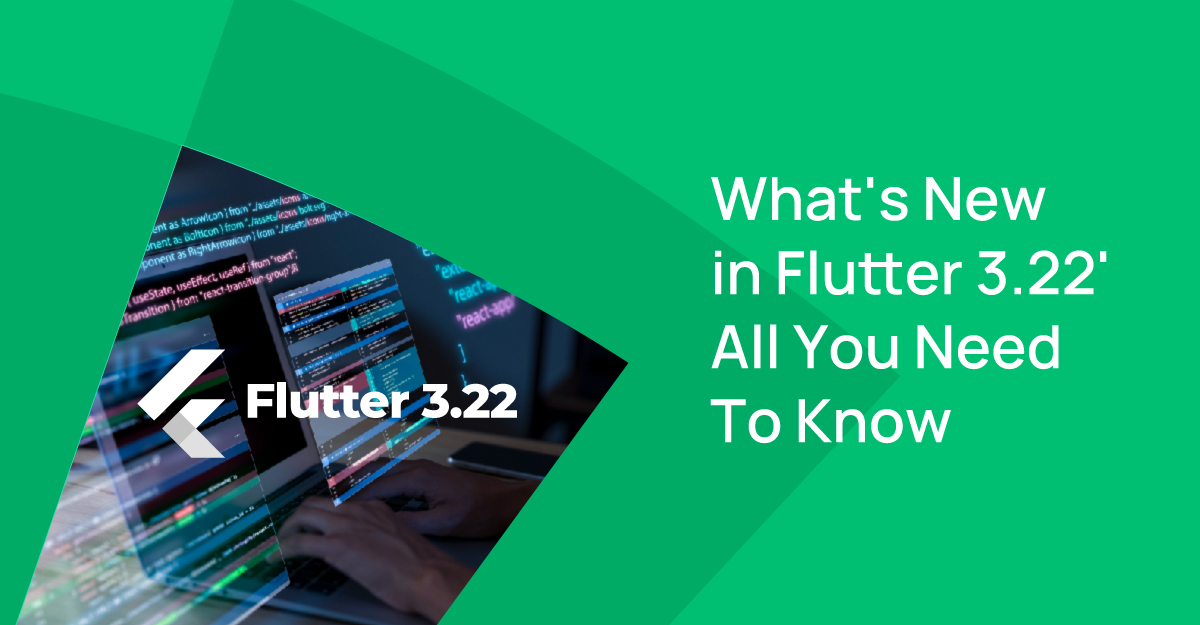Right when the news of Flutter's extinction began to spread, Google I/O announced the release of Futter 3.22 – its brand-new update.
The latest release of Google I/O, Flutter 3.22, was released on May 14, 2024, and it brings with it a number of improvements and changes that should make the process of developing apps even more efficient and seamless. The interesting changes to Flutter 3.22 version 2024 are bringing brighter times ahead for Flutter.
Let's discuss the most important updates from the Flutter 3.22 release!
Key Highlights of Flutter 3.22
Minor Breaking Changes
Stability has been considered in the design of Flutter 3.22. It brings some revolutionary modifications to the core framework and the Material Design system, which lessens the need for major restructuring and lets developers update their projects with less difficulty.
Firebase Issues
The enhancements for every known Firebase issue are included in Flutter 3.22 as one of its major upgrades. For many Flutter applications, Firebase integration is essential since it offers backend services like analytics, real-time databases, and authentication.
Such services are made possible by the lack of Firebase-related issues, which improves the dependability and efficiency of Flutter App Development Services.
Replace Outdated Libraries
Updating the codebase is essential for long-term performance and viability. To future-proof their apps, Flutter 3.22 encourages developers to use the latest features and optimizations while replacing outdated libraries with more modern options.
Reinstall the Build Files
To keep their Gradle scripts and build files compatible with the latest version of Flutter and its dependencies, developers are advised to regenerate build files like index.html.
It guarantees that the build procedure for the project continues to be updated for the new features and enhancements added in Flutter 3.22.
Framework Improvements
Flutter 3.22 improves the overall development experience by adding many upgrades to the framework:
Eliminate Order Dependency:
By making improvements, order-dependent circumstances are eliminated, increasing predictability and stability.
Enhance Leak Tracker:
Improved memory control and debugging via enhanced tools for tracking leaks.
New Form Validation Approach:
A more flexible and controllable form validation approach is introduced.
Dynamic View Scaling:
To increase layout flexibility, dynamic view scaling has been reintroduced.
Disable Test Shuffling:
In order to guarantee more dependable and consistent test runs, widget_tester_leaks_test.dart has tested shuffling turned off.
Resolve Spell Check Errors:
Spell check now handles text with regex reserved characters better.
Improved Leak Tracking Tests:
Tests for leak tracking have been improved, guaranteeing increased precision and dependability.
ProcessText QueryTextActions Handling:
Errors were prevented by better handling of null cases in ProcessText queryTextActions.
Text Style Debug Label:
To help with debugging, this ensures that debug labels in TextStyle copyWith are not overlooked.
NestedScrollView Enhancement:
Problems with NestedScrollView were fixed to enhance scrollable behavior and accuracy.
Updates for Material Widgets
The Material Design system has undergone significant upgrades and modifications with Flutter 3.22, improving user experience and giving developers more tools and freedom to create beautiful applications.
Let's explore some of the most noteworthy and important bug fixes and features made to the release:
Chip Improvements
- Better Chip Shape Customization: More accurate and adaptable design possibilities are now possible thanks to improvements made to the chip shape customization feature.
- Updates to the Chip Tests for Material 3: To ensure accuracy and consistency, the tests have been modified to match Material 3 requirements.
- Resolved Chip Icons and Label Color difficulties: A number of difficulties pertaining to chip icons and label colors have been fixed, enhancing the chip components' visual coherence.
Enhancements to the Selectable Region and Circular Progress Indicator
- Customized Toolbar for Text Selection on the System Android's SelectableRegion Buttons: The user experience is enhanced by the upgrade, which gives users more control over text selection behaviors.
- Fixes for Indeterminate CircularProgressIndicator on Darwin: Accurate progress indication has been restored by fixing bugs that affected the indeterminate condition of the CircularProgressIndicator on Darwin systems.
Updates for SearchBar and SearchAnchor
- Added ‘Enable’ Property to Disable the SearchBar: Developers now have additional control over search functionalities with the added ability to disable the SearchBar using the "Enable" property.
- Fixed Search View Clear Button Visibility: Usability has been improved by resolving issues with the clear button's visibility in the search view.
- Improved SearchAnchor Behavior: To maximize speed, SearchAnchor's behavior has been improved to minimize making pointless recommendation builder calls.
Improvements to TextField and TextFormField
- TextField Can Now Scroll When Disabled: This update enhances user experience and accessibility by enabling TextFields that are disabled to scroll.
- TextField Helper Top Padding on Material 3 has been Fixed: This ensures a consistent layout by resolving padding issues that were affecting the helper text in TextFields under Material 3.
- Resolved Suffix and Prefix Widget Tappability Issues in Input Decorators: This improves interaction by fixing problems with suffix and prefix widgets in input decorators.
Additional Fixes and Enhancements
- Multiple Typo Corrections and Documentation Updates: To increase accuracy and clarity, typos have been fixed and documentation has been updated.
- Cleaner Code by Refactoring If Chains into Switch Statements: To make the code more readable and maintainable, refactoring has been done.
- ShowBottomSheet and showModalBottomSheet now Support AnimationStyle: More possibilities for bottom sheet animations are now possible with the addition of new support for AnimationStyle.
- Fixed Problems with Scrollbar Thickness and Hover Behavior: The user interface has been enhanced by fixing bugs that affected the scrollbar thickness and hover behavior.
Platform-Specific Improvements
Substantial changes have been made to the Windows, iOS, and Android platforms in Flutter 3.22:
iOS Improvements
- Improved Native Debugging and Asset Handling Capabilities: Native asset management and debugging capabilities have been enhanced, making it easier to design iOS applications.
- Improved Wireless Debugging Support for iOS 12 and Below: With the addition of wireless debugging support for iOS 12 and previous versions, developers now have greater options.
- Better CI Logs Upload and Alert for iOS Devices Not Paired: In order to improve build reliability, Continuous Integration (CI) procedures have been improved with improved log upload handling and alerts for unpaired iOS devices.
Android Upgradations
- Gradle Kotlin DSL Replaced the Hello World App: Gradle Kotlin DSL has been used in the hello_world app migration, resulting in a more contemporary and manageable build script.
- PlatformViewRenderTargetSimplified: To improve usability, the PlatformViewRenderTarget interface has been simplified.
- CompliancewithBestPractices: To maximize performance, FlutterRenderer has included a number of best practices.
- SurfaceTextureSurfaceProducer: This feature was added to handle surface textures more effectively.
Windows Enhancements
- Check the Flutter Doctor Validator for the Bank of Brazil Security Module: To ensure compliance and security, the Windows Flutter Doctor validator now includes a new check for the Bank of Brazil security module.
- Better Android Platform Views: Performance and dependability have increased thanks to improvements made to Android Platform Views, especially for native elements like web views and maps.
Updates for Developer Tools
Major tool modifications are introduced in Flutter 3.22 to improve development workflows:
- Support for Native Assets in Android Add2app
- Support for Gradle Kotlin DSL
- Better Selection of Shader Targets
- Optimization of Asset Bundles
- Improved Gradle Version Management
The improvement makes it easier to integrate native assets into Android applications and streamlines the add-to-app procedure.
Code readability and maintainability are enhanced by more succinct and expressive build setups with Kotlin DSL thanks to Gradle's support for Kotlin DSL.
Graphics speed on Android is improved through improvements in shader target selection, which yields optimized shaders for various rendering situations.
App asset management and optimization are now simpler thanks to the streamlining of asset bundle management for increased performance.
Build problems are reduced thanks to updates to Gradle version management, which guarantee stability and compatibility with various Gradle releases.
Additions to the Engine and Impeller
Various updates have been made to the Flutter engine, which drives Flutter applications, with a particular emphasis on Impeller, the new rendering engine that will take the place of Skia. Among the significant advancements are:
- New Blur Effect
- Developments to the Shader Bundle
- Optimization of Rendering Pipeline
- Optimizing Memory Management
With improved downscaling and support for mipmaps in backdrop filters, a new blur effect has been added. Applications become more visually appealing as a result of their improved visual effects.
Improved support for Vulkan runtime effects/fragment program API and uniform structs has been implemented, giving developers more robust tools to create intricate shaders.
Rendering efficiency and speed are increased via rendering pipeline optimizations such as direct writing to block-allocated device buffers and incremental allocation of the descriptor pool.
By decreasing shared pointer copies and increasing buffer usage during compute processes, memory management has been optimized. These modifications improve the Flutter applications' overall stability and performance.
Integration of WebAssembly
With Flutter 3.22, one of the main features is the addition of WebAssembly (Wasm) support on the stable channel. Wasm provides considerable speed gains, especially for programs that have intricate transitions and animations.
Wasm increased frame rendering times by three times in the worst-case circumstances and two times on average in internal benchmarks. Flutter apps are more engaging on the web thanks to their more responsive user interface and fluid animations.
Vertex AI for Firebase Dart SDK
With Flutter 3.22, developers can now incorporate generative AI elements into their apps with a sample of the Vertex AI for Firebase Dart SDK.
The SDK is built for production environments, providing scalability and performance along with the inclusion of Firebase App Check to safeguard backend infrastructure.
Developers may utilize Vertex AI to add sophisticated machine learning models to their apps, giving users more customized and inventive experiences.
Innovative Modifications and Revisions
PatternColor.fromSeed
When utilizing ColorScheme.fromSeed with high chroma values, developers are advised to use DynamicSchemeVariant.fidelity or DynamicSchemeVariant.content to ensure colorful palettes.
Removal of v1 Android Embedding
All support for the Android embedding version one has been eliminated. According to Flutter's migration instructions, developers must upgrade to version two.
Wrapping It Up
App development is now more productive and interesting thanks to the numerous fixes and new capabilities included in Flutter 3.22.
With improved tooling support, increased performance, and new features like WebAssembly and Vertex AI integration, Flutter keeps making it possible for a Flutter App Development Company in India to produce excellent cross-platform apps.
It's essential to keep up with the latest changes to Flutter's ecosystem. Leveraging such innovations requires hiring Flutter 3 developers with experience who know how to make the most of the technology.



